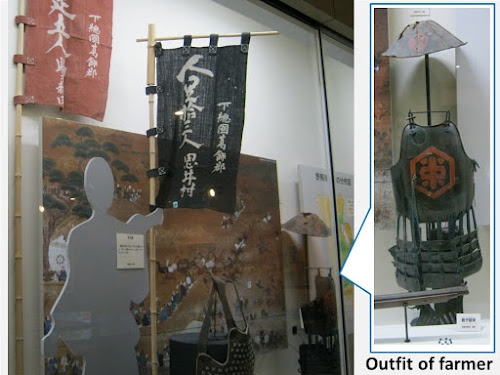He dispatched his farmers to O-shishigari or
deer hunting. Around 150,000 people joined the event. Farmers made a big circle which diameter was around twenty kilo-meters, surrounded animals and gathered them to the spot where samurais hunted them.
鹿狩りでは、15万人を動員し、約20kmの輪を作り、鹿や猪などの動物を囲っていく。最後に武士が、弓矢で射止める。
【March part1: Join the O-shishigari、3月その1:鹿狩りに出立】
- On the 15th, the send-off party for the dispatched 9 farmers was held. One supervisor, six hunters and two flag-bearers were dispatched. Three bottles of sake, tofu and konjac were given to them as a gift. The party lasted until night time, and this would be their time to have fun.
- On the 16th, 10 farmers left their village about 5 am. They were 9 farmers and 1 carrier. They camped 2 nights and went back to the village on the 18th.
On the 17th, the master went out to see O-shishigari.
On the 18th, the master joined the party with farmers who participated in O-shishigari.
It would be a really exciting event in such an uneventful village. I respect the shogunate because they allowed people to look at O-shishigari and they permitted merchants to open the stalls in the venue. It was a great gift from the shogunate which people paid heavy tax every year. The master’s mother’s home was designated the inn for samurai, so Otoki, who was a lady in his house, was dispatched to help the home.
1 8日は、帰村した人足たちと宴会となる。
【March part3: Daily life、3月その3:日々の暮らし】
On the 3rd, Shiba families visited Nakadera temple and they offered rice cakes and a big bottle of sake.
Previous post: Yoshino’s daily life 03, from Jan. to February in 1849(嘉永2年)
Yoshino’s daily life 02, Life and fun of Yoshino family 吉野家の暮らしと楽しみ
Next post : "Kou" which was good gathering in the old time
Kou 講 (Glossary)
- On the 15th, the send-off party for the dispatched 9 farmers was held. One supervisor, six hunters and two flag-bearers were dispatched. Three bottles of sake, tofu and konjac were given to them as a gift. The party lasted until night time, and this would be their time to have fun.
 |
Flags and outfit of O-shishigari farmers in Nagareyama museum
お鹿狩りでの農民の装束 @ 流山市博物館
|
- On the 16th, 10 farmers left their village about 5 am. They were 9 farmers and 1 carrier. They camped 2 nights and went back to the village on the 18th.
On the 17th, the master went out to see O-shishigari.
On the 19th, villagers
quitted farming at noon; they enjoyed sake or rice wine in the afternoon, because O-shishigari
was so successful. I think they enjoyed the stories of dispatched farmers as
hunters and galleries, I am sure that hunters became heroes. By the way, 265
animals were captured in this O-shishigari.
They got
reward from the local office and got durable ropes which were used in O-shishigari. 15日、お鹿狩りに派遣する農民達の送別会。豆腐とこんにゃくで酒を飲む。夜遅くまで続いたと言うから、楽しい会でした。
16日、暁七つ過ぎ(午前5時ごろ)、10人(人足6人、幟持ち2人、荷持ち1人、才領1人、ロジスティックも指揮者も整っている)が出かける。2泊し、18日に帰村。
17日、鹿狩り拝見。
19日、鹿狩りが首尾よくいったので、昼から休日とし、村中で神酒を飲む。
(土産話で盛り上がったことだろう。人足がヒーローになる。ちなみに、この時の成果は、鹿、猪など265匹と伝えられている。)
この後、役所から費用を頂戴したり、用済みの猪網をもらったりしている。
【March part2: Enjoyed the O-shishigari show、3月その2:鹿狩り見物】
This O-shishigari was a big event since
it was held the first time after five decades. It was held in an off-season for
farmers, so more than 20,000 people could visit the venue to watch it.
On the 6th, the master
visited the venue with someone, and he checked the place where the shogun would
stand and evaluate the exercise.
On the 9th, his mother
went to Matsudo to see the temporary bridge which consisted of 21 boats. The
shogun and his troop would get on the horses and cross the river 8 days later.
On the 13th, the master went to the
bridge too, which was 10km away from his house. His mother would have strongly recommended
him to scrutinize the bridge.
On the 16th, his
acquaintances visited his house in order to watch O-shishigari and they stayed there
for three nights.
Temporary boat bridge、松戸宿船橋
https://dl.ndl.go.jp/info:ndljp/pid/1302626?tocOpened=1
鹿狩りは約50年ぶりとなる大行事、しかも、農繁期前。多くの人が見物に出かけている。
6日、将軍が観閲するお立場に、主人が誰かと行っている。
9日、母親が、お立場と将軍が馬で江戸川を渡るための松戸船橋を見物している。
13日、母の話を聞いてか、主が松戸船橋を拝見
16日、江戸から知人が鹿狩りを見物に来て3泊する。
17日、鹿狩り拝見。
On the 18th, the master joined the party with farmers who participated in O-shishigari.
It would be a really exciting event in such an uneventful village. I respect the shogunate because they allowed people to look at O-shishigari and they permitted merchants to open the stalls in the venue. It was a great gift from the shogunate which people paid heavy tax every year. The master’s mother’s home was designated the inn for samurai, so Otoki, who was a lady in his house, was dispatched to help the home.
何もない村で、ビックイベントだ。見物させた江戸幕府も偉い。イベントは民心を高揚するために大切だ。母親の出もとの、柏、名戸が谷は御用宿となり、おときを手伝いに出している。
Their daily life continued during O-shishigari.
The season was changing from frozen winter to spring. Every
creature was becoming vivid and fresh.
On the 3rd, Shiba families visited Nakadera temple and they offered rice cakes and a big bottle of sake.
On the 4th, they visited Tekona-Kou (religious group) and stayed at a host's house.
On the 7th, Oshi or travel agent
came to Yoshino’s house. Officers from Kouyasan also came. The master stayed at
Nakamura’s house in order to participate in Mujin-Kou.
On the 17th, it was O-shishigari day.
On the 20th, they enjoyed taro soup
and sake. Nakamura came.
On the 22nd, they visited Nakadera
temple and offered green rice cakes.
鹿狩りの間も、日々の暮らしは淀みなく続く。寒い冬から、水ぬるむ春に移る季節である。全てが生命を帯びてきて、みずみずしい。
3日は、芝三家が中寺へ、餅と酒一枡を持って参詣。
4日、手児奈講(泊まり)
7日、富士御師、高野山北室手代が来訪、中村勘右衛門家にて無盡
20日、芋汁・酒、中村勘右衛門らが来宅。
22日、中寺に草もちを持っていく。
地味だが、こういうのもいいなあ、癒される日記だ。
Previous post: Yoshino’s daily life 03, from Jan. to February in 1849(嘉永2年)
Next post of Yoshino's diary : Yoshino’s daily life 05, from April to May in 1849 (嘉永2年春)
Next post : "Kou" which was good gathering in the old time
Kou 講 (Glossary)


Comments
Post a Comment